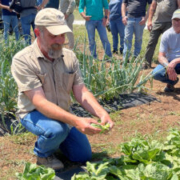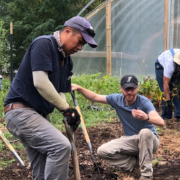Agritourism for Beginners
 Print This Post
Print This Post
By Luz Ballesteros Gonzalez, NCAT Agriculture Specialist
The first time I visited a local farm, I was beyond excited to see carrots and cauliflowers grow. As a life-long agritourist, I still stare in awe at the vegetables growing on the farms I visit today. Agritourism has become quite popular among city dwellers like me because it allows connecting and learning about where food comes from and experiencing a different cultural landscape. It can be a great secondary source of income for regenerative agricultural producers and serve as an opportunity to connect with the public and gain loyal customers.
There are many resources for producers looking to start incorporating agritourism. Here are key points to have in mind as you begin planning.
Land and Infrastructure
One thing to consider is your land layout. While you don’t necessarily need a breathtaking natural feature, it is important to keep in mind the spaces you will be setting aside for visitors, accommodating parking, and the accessibility of those spaces. Another factor to consider is infrastructure — meeting guest expectations by having clean facilities and access to public bathrooms if your agritourism enterprise will host for extended periods, as stated in this Cornell Cooperative Extension Guide. In this case, first impressions do matter!
Liability and Insurance
Nobody likes to think about paying for another insurance, but if you plan on hosting agritourists, this should be a priority on your to-do list. The exact definition might vary slightly by state, but it is clear that if individuals are paying to be on your property, you want to ensure that it is reasonably safe to do so. If things don’t go as planned, it’s important to have that liability insurance to cover your operation. To understand what’s the best fit and whether you would benefit from making your agritourism business a separate business entity, you should consult with your lawyer and insurance agent. If you do not currently have a lawyer, The National Agricultural Law Center is a great resource to start navigating the complicated world of liability.
Marketing and Services
Agritourism operations range from small garden tours and u-picks to large bed-and-breakfast demonstration ranches. The services you offer will depend on how your agritourism enterprise looks, but some things that could be done to increase your revenue and exposure are:
- Selling value-added products at the end of tours or workshops (this could be jam if you grow strawberries or salsa if you grow hot peppers)
- Organizing events by partnering with local organizations
- Providing people with links to your social media and maintaining a social media presence
- Providing individuals with multiple options for payment such as credit card, cash, Venmo, cash app, Zelle, or PayPal
- Adding your agritourism enterprise to a platform like Farm Stay U.S.A.
The services you provide and the location of your farm might directly affect your initial pricing. It is vital to keep in mind your fixed costs and variable costs. The Guide to Successful Agritourism Enterprise is a great resource to get started planning your marketing and services.
Incorporating agritourism should not be stressful or add more labor to your existing operation, which is why these four key points are crucial. In addition, NCAT specialists are here to help as you embark on a new journey to share your passion for regenerative agriculture with the public.
Related ATTRA Resources
Lavender Production, Markets, and Agritourism
Other Resources
Getting Started in Agritourism
A Guide to Successful Agritourism Enterprises
This blog is produced by the National Center for Appropriate Technology through the ATTRA Sustainable Agriculture program, under a cooperative agreement with USDA Rural Development. ATTRA.NCAT.ORG.









 NCAT
NCAT

